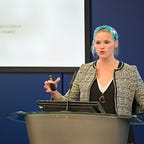Smart Copenhagen
What’s in it for me? (2015)
Originally published by Gehlpeople.com on June 3, 2015.
For years, Copenhagen has exported its Hans Christian Andersen fairy tale-like quaintness with an added spice of a generous welfare system and a profound respect for recreational time. For the 21st century, Copenhagen will not just be exporting world-class ‘livability’; it will also brand itself on being a ‘smart city’.
The Solutions Lab
During the last few years, Copenhagen’s municipality has undertaken a series of projects aimed at creating smart solutions for the daily organisation of the city. These initiatives range from the careful controlling of traffic, to monitoring of air quality, publicised open city data, and fun informative apps. Last year, the City of Copenhagen’s smart city incubator ‘Copenhagen Solutions Lab’ received the ‘World Smart Cities Award’ for their project ‘Copenhagen Connecting’; a system that monitors and compares traffic, air quality, waste management, energy use etc. in real time. The idea is that this data will help the city (and its citizens) by for instance reducing the time it might take for an ambulance to reach an accident, by warning people against a possible flood or by informing authorities in case the environment of a certain area reaches a critical level of pollution. The ability of this new grid to measure and compare many different kinds of data could open up a completely new efficiency level in the organisation of the city. From the city of Copenhagen’s point of view, it all sounds very smart. But what does it have to do with me?
Has the Smart City reached its full potential when computers control every mechanism, and environmental challenges, accidents and our waste collection all take care of themselves? I think not. There must be something in the smart city that benefits human interaction, the experience of spaces in the city and the connectivity between people in otherwise notoriously anonymous metropolises. But what could this “something” be?
Street-smart bicycling culture
In Copenhagen, I have managed to find a couple of examples within the bicycle community that restore my faith in smart technology and the digitisation of society. The strong bicycling culture has, I think, inspired a series of smart initiatives within this field that are not just smart for city organisation but for people too. Here’s a list of my favourite smart bicycling initiatives:
- ‘I BIKE CPH’ has launched a route-planner app, which utilizes user-feedback in order to improve its recommendations. Soon, it will also be able to measure how many kilometres you’ve cycled as well as the number of calories you’ve burned. These features could contribute to motivating more people to cycle, improving the health and the environment in the city — a pretty smart use of technology, right?
- A couple of students from the Technical University of Denmark (DTU) have used the city’s public data from traffic signals to create a beta-app that guides cyclists on how fast they need to ride to hit the green lights. This app is currently being developed to cover the entire city. I am especially fond of this initiative, because it shows that anyone can contribute to the smart city, as long as the data is open and accessible. In addition, it manifests the possibility of new creative collaborations between the city and its citizens.
- Another example of smart technology use when cycling in Copenhagen is on Facebook. Thousands of Copenhageners have formed a group on Facebook (and on Twitter) warning each other of bicycle-related police activity, to avoid silly fines. It could be promising for the community feeling in cities that strangers are able to use their smartphones to form alliances and help each other abide the law and navigate the streets.
The bicycle traffic is monitored and displayed all over the city, so even on a snowy, cold day, you can see you are no. 2937 to cycle along. The city collects this data and uses it to motivate more bicycling.
Real-time or real-space?
Still, the link between what goes on in the ethereal spaces of technology and the actual life in real public spaces is weak. Smart Copenhagen enables us to interact with each other and with the city in “real-time”, but what I would really like to see is some “real-space” action. In terms of space, there are not many physical examples of how smart technology improves our phenomenological experience of the city — as is the case in soon-to-be-smart cities all over the world. As a Copenhagener, I shall hold my breath while I wait to see how the smart movement will influence and change the city’s public life and public spaces.
